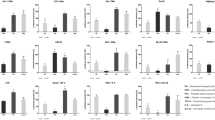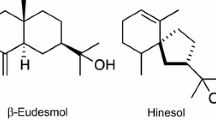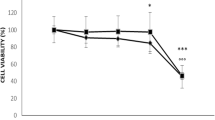Abstract
Homeobox A9 (HOXA9) is a transcription factor that is overexpressed in acute myeloid leukemia (AML). It is associated with the pathogenesis and progression of AML, and is a factor responsible for a poor prognosis. Therefore, the development of HOXA9-targeting molecules may contribute to not only better understanding of the mechanism of HOXA9 regulation, but also the development of therapeutic applications. We constructed a reporter assay system using the promoter region of the KBTBD10 gene, to which HOXA9 directly binds and regulates transcription, in the human acute monocytic leukemia cell line THP-1. Using this luciferase gene assay, we screened 1120 plant extracts and a methanol extract of the unripe fruits of Cerbera manghas was found to suppress the reporter gene expression mediated by the KBTBD10 promoter. From the extract, five steroid-type compounds were identified as the active constituents: 7α-neriifolin (1), 17β-neriifolin (2), 17α-digitoxigenin β-d-glucosyl-(1 → 4)-α-l-thevetoside (3), 17β-digitoxigenin β-d-glucosyl-(1 → 4)-α-l-thevetoside (4), and acetylthevetin B (5). Among the five compounds, 17β-neriifolin most potently inhibited HOXA9-dependent gene expression without affecting the HOXA9 mRNA levels, and suppressed cell proliferation by inducing apoptosis. The findings on the structure–activity relationships of the compounds from C. manghas may contribute to the development of small molecule inhibitors of HOXA9.




Similar content being viewed by others
References
Shah N, Sukumar S (2010) The Hox genes and their roles in oncogenesis. Nat Rev Cancer 10:361–371
Gonçalves CS, Magalhães AX, Pojo M, Oliveira AI, Correia S, Reis RM, Sousa N, Rocha M, Costa BM (2015) Transcriptional profiling of HOXA9-regulated genes in human glioblastoma cell models. Genom Data 5:54–58
Luís ASP, Pinheiro PC, Ferreira MJ, Antunes L, Lobo F, Oliveira J, Henrique R, Jerónimo C (2017) Identification of clear cell renal cell carcinoma and oncocytoma using a three-gene promoter methylation panel. J Transl Med 15:149
Malek R, Gajula RP, Williams RD, Nghiem B, Simons BW, Nugent K, Wang H, Taparra K, Chlieh GL, Yoon AR, True L, An SS, DeWeese TL, Ross AE, Schaeffer EM, Pienta KJ, Hurley PJ, Morrissey C, Tran PT (2017) TWIST1-WDR5-Hottip regulates Hoxa9 chromatin to facilitate prostate cancer metastasis. Cancer Res 77:3181–3193
Ma YY, Zhang Y, Mou XZ, Liu ZC, Ru GQ, Li E (2017) High level of homeobox A9 and PBX homeobox 3 expression in gastric cancer correlates with poor prognosis. Oncol Lett 14:5883–5889
Vijapurkar U, Fischbach N, Shen W, Brandts C, Stokoe D, Lawrence HJ, Largman C (2004) Protein kinase C-mediated phosphorylation of the leukemia-associated HOXA9 protein impairs its DNA binding ability and induces myeloid differentiation. Mol Cell Biol 24:3827–3837
Ng SWK, Mitchell A, Kennedy JA, Chen WC, McLeod J, Ibrahimova N, Arruda A, Popescu A, Gupta V, Schimmer AD, Schuh AC, Yee KW, Bullinger L, Herold T, Görlich D, Büchner T, Hiddemann W, Berdel WE, Wörmann B, Cheok M, Preudhomme C, Dombret H, Metzeler K, Buske C, Löwenberg B, Valk PJM, Zandstra PW, Minden MD, Dick JE, Wang JCY (2016) A 17-gene stemness score for rapid determination of risk in acute leukaemia. Nature 540:433–437
Golub TR, Slonim DK, Tamayo P, Huard C, Gaasenbeek M, Mesirov JP, Coller H, Loh ML, Downing JR, Caligiuri MA, Bloomfield CD, Lander ES (1999) Molecular classification of cancer: class discovery and class prediction by gene expression monitoring. Science 286:531–537
Kroon E, Thorsteinsdottir U, Mayotte N, Nakamura T, Sauvageau G (2001) NUP98-HOXA9 expression in hemopoietic stem cells induces chronic and acute myeloid leukemias in mice. EMBO J 20:350–361
Calvo KR, Sykes DB, Pasillas M, Kamps MP (2000) Hoxa9 immortalizes a granulocyte-macrophage colony-stimulating factor-dependent promyelocyte capable of biphenotypic differentiation to neutrophils or macrophages, independent of enforced meis expression. Mol Cell Biol 20:3274–3285
Kroon E, Krosl J, Thorsteinsdottir U, Baban S, Buchberg AM, Sauvageau G (1998) Hoxa9 transforms primary bone marrow cells through specific collaboration with Meis1a but not Pbx1b. EMBO J 17:3714–3725
Lawrence HJ, Helgason CD, Sauvageau G, Fong S, Izon DJ, Humphries RK, Largman C (1997) Mice bearing a targeted interruption of the homeobox gene HOXA9 have defects in myeloid, erythroid, and lymphoid hematopoiesis. Blood 89:1922–1930
Izon DJ, Rozenfeld S, Fong ST, Kömüves L, Largman C, Lawrence HJ (1998) Loss of function of the homeobox gene Hoxa-9 perturbs early T-cell development and induces apoptosis in primitive thymocytes. Blood 92:383–393
Faber J, Krivtsov AV, Stubbs MC, Wright R, Davis TN, van den Eibrink MH, Zwaan CM, Kung AL, Armstrong SA (2009) HOXA9 is required for survival in human MLL-rearranged acute leukemias. Blood 113:2375–3238
Depauw S, Lambert M, Jambon S, Paul A, Peixoto P, Nhili R, Marongiu L, Figeac M, Dassi C, Constant CP, Billoré B, Kumar A, Farahat AA, Ismail MA, Mineva E, Sweat DP, Stephens CE, Boykin DW, Wilson WD, Cordonnier MHD (2019) Heterocyclic diamidine DNA ligands as HOXA9 transcription factor inhibitors: design, molecular evaluation, and cellular consequences in a HOXA9-dependant leukemia cell model. J Med Chem 62:1306–1329
Takase S, Kurokawa R, Arai D, Kanto KK, Okino T, Nakao Y, Kushiro T, Yoshida M, Matsumoto K (2017) A quantitative shRNA screen identifies ATP1A1 as a gene that regulates cytotoxicity by aurilide B. Sci Rep. https://doi.org/10.1038/s41598-017-02016-4
Maemoto Y, Ono Y, Kiso S, Shibata H, Takahara T, Sorimachi H, Maki M (2014) Involvement of calpain-7 in epidermal growth factor receptor degradation via the endosomal sorting pathway. FEBS J 281:3642–3655
Yun YS, Shioura M, Hitotsuyanagi Y, Yotsumoto S, Takahashi Y, Aoyagi Y, Kinoshita T, Takeya K, Inoue H (2021) Garcinielliptone G from Garcinia subelliptica induces apoptosis in acute leukemia cells. Molecules 26:2422
Yassin ER, Sarma NJ, Nabi AMA, Dombrowski J, Han Y, Takeda A, Yaseen NR (2009) Dissection of the transformation of primary human hematopoietic cells by the oncogene NUP98-HOXA9. PLoS ONE 4:e6719
Yamauchi T, Abe F, Wan ASC (1987) Cardenolide monoglycosides from the leaves of Cerbera odollam and Cerbera manghas (Cerbera. III). Chem Pharm Bull 35:2744–2749
Yamauchi T, Abe F, Wan ASC (1987) Studies on Cerbera. IV.1 polar cardenolide glycosides from the leaves of Cerbera odollam and Cerbera manghas. Chem Pharm Bull 35:4813–4818
Kohls S, Scholz-Böttcher BM, Teske J, Zark P, Rullkötter J (2012) Cardiac glycosides from yellow oleander (Thevetia peruviana) seeds. Phytochemistry 75:114–127
Tian DM, Cheng HY, Jiang MM, Shen WZ, Tang JS, Yao XS (2016) Cardiac glycosides from the seeds of Thevetia peruviana. J Nat Prod 79:38–50
Dorsam ST, Ferrell CM, Dorsam GP, Derynck MK, Vijapurkar U, Khodabakhsh D, Pau B, Bernstein H, Haqq CM, Largman C, Lawrence HJ (2004) The transcriptome of the leukemogenic homeoprotein HOXA9 in human hematopoietic cells. Blood 103:1676–1684
Ghannam G, Takeda A, Camarata T, Moore MA, Viale A, Yaseen NR (2004) The oncogene Nup98-HOXA9 induces gene transcription in myeloid cells. J Biol Chem 279:866–875
Maharana PK (2021) Ethnobotanical, phytochemical, and pharmacological properties of Cerbera manghas L. J Biosci 46:25
Zhao Q, Guo Y, Feng B, Li L, Huang C, Jiao B (2011) Neriifolin from seeds of Cerbera manghas L. induces cell cycle arrest and apoptosis in human hepatocellular carcinoma HepG2 cells. Fitoterapia 82:735–741
Wang JKT, Portbury S, Thomas MB, Barney S, Ricca DJ, Morris DL, Warner DS, Lo DC (2006) Cardiac glycosides provide neuroprotection against ischemic stroke: discovery by a brain slice-based compound screening platform. Proc Natl Acad Sci USA 103:10461–10466
Tsai JC, Liu WS, Tseng YT, Lam HI, Chen SY, Fang CL, Tong TS, Lai YJ (2018) Extracts of Cerbera manghas L. effectively inhibit the viability of glioblastoma cell lines and their cancer stemloids in vitro and in mouse xenograft model. J Funct Foods 48:283–296
Sonoda Y, Itoh M, Tohda S (2021) Effects of HOXA9 inhibitor DB818 on the growth of acute myeloid leukaemia cells. Anticancer Res 41:1841–1847
Acknowledgements
We thank Dr. T. Kitamura of The University of Tokyo for providing the PLAT-E cells. We also thank Dr. H. Nakano of Tokyo University of Pharmacy and Life Sciences for technical support for electroporation.
Author information
Authors and Affiliations
Corresponding author
Ethics declarations
Conflict of interest
The authors have no financial relationships to disclosure.
Additional information
Publisher's Note
Springer Nature remains neutral with regard to jurisdictional claims in published maps and institutional affiliations.
Supplementary Information
Below is the link to the electronic supplementary material.
Rights and permissions
Springer Nature or its licensor (e.g. a society or other partner) holds exclusive rights to this article under a publishing agreement with the author(s) or other rightsholder(s); author self-archiving of the accepted manuscript version of this article is solely governed by the terms of such publishing agreement and applicable law.
About this article
Cite this article
Takase, S., Yun, Y.S., Moriya, F. et al. 17β-neriifolin from unripe fruits of Cerbera manghas suppressed cell proliferation via the inhibition of HOXA9-dependent transcription and the induction of apoptosis in the human AML cell line THP-1. J Nat Med 77, 180–187 (2023). https://doi.org/10.1007/s11418-022-01659-6
Received:
Accepted:
Published:
Issue Date:
DOI: https://doi.org/10.1007/s11418-022-01659-6




